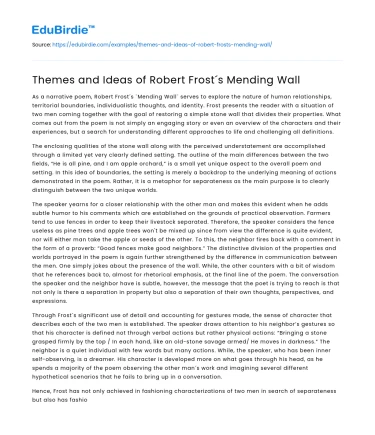As a narrative poem, Robert Frost´s ¨Mending Wall¨ serves to explore the nature of human relationships, territorial boundaries, individualistic thoughts, and identity. Frost presents the reader with a situation of two men coming together with the goal of restoring a simple stone wall that divides their properties. What comes out from the poem is not simply an engaging story or even an overview of the characters and their experiences, but a search for understanding different approaches to life and challenging all definitions.
The enclosing qualities of the stone wall along with the perceived understatement are accomplished through a limited yet very clearly defined setting. The outline of the main differences between the two fields, “He is all pine, and I am apple orchard,” is a small yet unique aspect to the overall poem and setting. In this idea of boundaries, the setting is merely a backdrop to the underlying meaning of actions demonstrated in the poem. Rather, it is a metaphor for separateness as the main purpose is to clearly distinguish between the two unique worlds.
Save your time!
We can take care of your essay
- Proper editing and formatting
- Free revision, title page, and bibliography
- Flexible prices and money-back guarantee
The speaker yearns for a closer relationship with the other man and makes this evident when he adds subtle humor to his comments which are established on the grounds of practical observation. Farmers tend to use fences in order to keep their livestock separated. Therefore, the speaker considers the fence useless as pine trees and apple trees won't be mixed up since from view the difference is quite evident, nor will either man take the apple or seeds of the other. To this, the neighbor fires back with a comment in the form of a proverb: “Good fences make good neighbors.” The distinctive division of the properties and worlds portrayed in the poem is again further strengthened by the difference in communication between the men. One simply jokes about the presence of the wall. While, the other counters with a bit of wisdom that he references back to, almost for rhetorical emphasis, at the final line of the poem. The conversation the speaker and the neighbor have is subtle, however, the message that the poet is trying to reach is that not only is there a separation in property but also a separation of their own thoughts, perspectives, and expressions.
Through Frost´s significant use of detail and accounting for gestures made, the sense of character that describes each of the two men is established. The speaker draws attention to his neighbor’s gestures so that his character is defined not through verbal actions but rather physical actions: “Bringing a stone grasped firmly by the top / In each hand, like an old-stone savage armed/ He moves in darkness.” The neighbor is a quiet individual with few words but many actions. While, the speaker, who has been inner self-observing, is a dreamer. His character is developed more on what goes through his head, as he spends a majority of the poem observing the other man´s work and imagining several different hypothetical scenarios that he fails to bring up in a conversation.
Hence, Frost has not only achieved in fashioning characterizations of two men in search of separateness but also has fashioned two individualistic, unconnected entities that touch upon human differences. This engaging and compelling difference between the two is founded on Frost´s astonishing diction and delivery. He manages to be colloquial yet profound. There are several lines throughout the work that tempt the mind and please the voice due to rhythm and the short and conversational words. Even repetition as noted with the lines 'Something there is that doesn’t love a wall,' and 'Good fences make good neighbors' serve as a tension piece to draw attention to the different sides of the argument. Moreover, the poem doesn’t contain any stanza breaks, which allows the work to visually reflect a rock wall turned on its side. The ¨cracks¨ or ¨holes¨ in the stone wall is visible in the way that the line endings form a jagged line that goes up and down. These techniques work cohesively to allow the ¨Mending Wall¨ to resonate so consummately with readers.






 Stuck on your essay?
Stuck on your essay?

